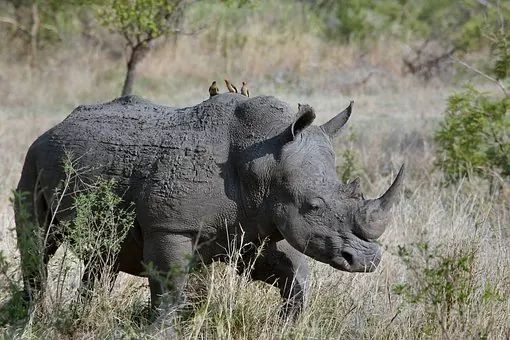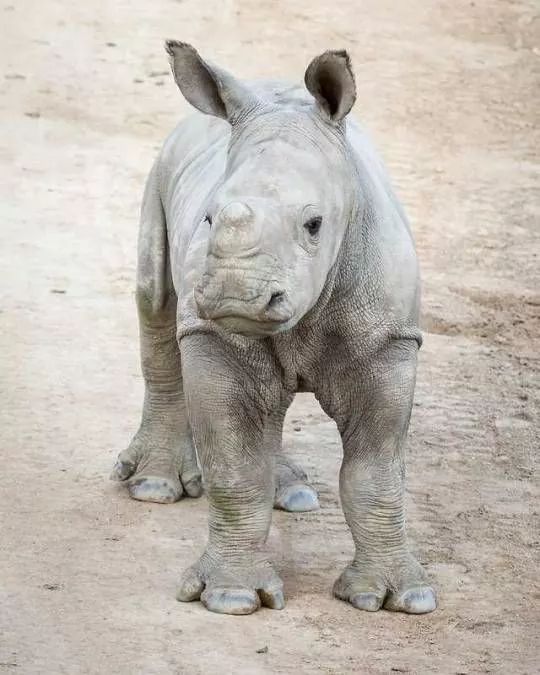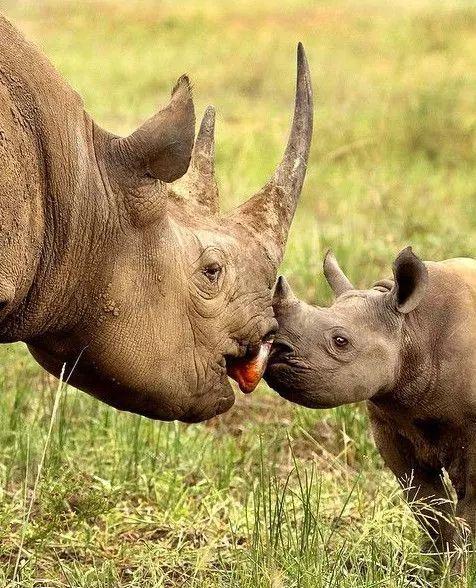
Although African rhinos have a thick skin; they also have a sensitive skin and biting parasites really bother them — they often roll in mud and once dried, enjoy rubbing the hard mud and caked parasites off on a tree stump, or similar.
The African rhinos that whistles (they make a loud whistle blow when the female looks for a mate — sounds like the call of a humpbacked whale).

The above are not an African rhinos, but we think this should be of interest. The rarest and smallest rhino in the world is the rhino found on the Indonesian Islands of Sumatra, Asia — only about 60 rhinos are left in the wild.
What makes this so heartbreaking is that they are very, very difficult to breed in captivity — only 2 captive females bred within 15 years!
- They are the only two horned rhinos in Asia and just look how tiny their horns are in a mature animal — that big animal is killed just for a few centimetres!
White African rhinos have longer horns than black rhinos and we once saw magnificent rhinos walking freely in the wild with impressive horns that could reach 5 feet. The long horn is the front horn and sits just above the nasal cavity and the smaller second horn (back) is located above the frontal bones of the skull — that is why most 98 -99% of them die as they (poachers) chop too deep.

An African rhino is an odd-toed ungulate. An ungulate is a mammal with hooves. A rhino has three toes — so three hooves and this is why they are related to the horse, although we see only one hoof, there are signs, still showing, that they were like the rhino and also had three toes.
‘Three’ is an odd number (in maths), so therefore it is called an ‘odd-toed ungulate’.

A black rhino is also called the hook-lipped rhino, because of its long and pointed top lip. This lip is prehensile — ‘prehensile means it can grab things (like most monkeys have a prehensile tail), so that the rhino can grab leaves and fruit off trees.
Why White African rhinos are called the ‘white’ rhino?
It is because when they were first described, the Dutch settlers described this rhino as the rhino with the ‘weit/wjyd’ lip — As in ‘wide’ lip. It kind of got a bit messed up in translation and ended up as ‘wit’ (Afrikaans word for ‘white’), and then translated into English and called ‘white’. So, that is how the name ‘white rhino’ came to be, and has nothing to do with their actual colour.
Black African Rhinos
The black African rhinos is also called the ‘hooked-lip rhino’, because it has a pointed mouth — its front lip is long (elongated) and pointed — also, it can grab things — like leaves. It has a prehensile top lip. It also got its name from early explorers as it often forages near water and often rests in the mud or the shallows. So, when it rose the wet skin looked black from a distance — hence the name ‘black rhino’. Also nothing to do with the rhino’s actual greyish colour.
Facts about African Rhino Horn
- Four rhino species and one subspecies are protected as endangered under the U.S. Endangered Species Act. This law makes it illegal to import or export rhino and rhino parts and products; it also prohibits interstate commerce. Rhinos are also protected globally under the Convention on International Trade in Endangered Species.
- These animals face extinction in part because of the world’s longstanding lust for their horn, which has been valued
for centuries as a carving material and medicinal. - African Rhino horn is made up primarily of keratin – a protein found in hair, fingernails, and animal hooves. When carved
and polished, horn takes on a translucence and luster that increase as the object ages. - In ancient Greece, rhino horn was believed to have the ability to purify water.
- Persians in the 5th century B.C. thought that African rhino horn vessels could be used to detect poisoned liquids, which would
bubble when poured into such cups. - Four world religions (Hinduism, Islam, Buddhism and Christianity) at times shared this belief, as did the crowned heads of Europe up through the 18th and 19th centuries. And, in fact, chemists have concluded that there may be some truth in the theory – if the poisons happen to be alkaloids, which might react with the keratin in the rhino horn.
- Artisans in China used rhino horn for ornamentation as long ago as the 7th century. For hundreds of years, it was customary for Chinese nobles to mark the emperor’s birthday with the gift of a carved rhino horn “libation cup.”
- Museums and private collectors worldwide prize these antiques for both their beauty and monetary value.
- In Yemen, African rhino horn was long used for making the handles of special curved daggers that are presented to adolescent
boys as a sign of manhood and devotion to Islam. - The ornamental application of rhino horn was a “high society” decorative “fad” in Europe in the late 19th and early
- 20th centuries. Through the 1920s, items made from horn ranged from walking sticks and door handles to pistol grips
and limousine interiors. - The medicinal use of rhino horn also dates back centuries.
- Medical practitioners in such Asian countries as Malaysia, Korea, Vietnam, India and China used it as a treatment for
many different symptoms and illnesses. - In traditional Chinese medicine, ground rhino horn was prescribed for lowering fever and ameliorating such disorders
as rheumatism and gout. - Other uses in traditional medicine included treating snakebite, boils, food poisoning, and possession by spirits as well as curing headaches, hallucinations, high blood pressure, and typhoid.
- Scientists have little evidence to support belief in the medical efficacy of rhino horn, and many practitioners of traditional medicine have stopped using it in light of the species’ plight. Yet such belief persists and is fueled by
“urban legends” old or new about its powers as an aphrodisiac or cure for cancer. - Medicinal use continues to create demand for rhino horn – a demand that poses a threat to the continued survival of
rhino species in the wild.

